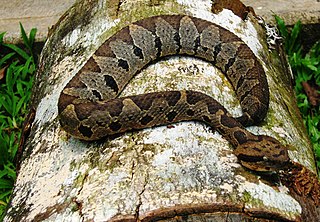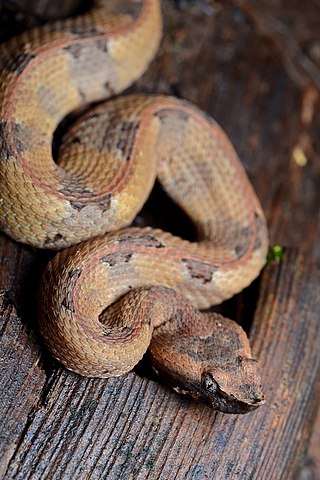
Bothriechis is a genus of pit vipers, commonly called palm vipers or palm-pitvipers found predominantly in Mexico and Central America, although the most common species, B. schlegelii, ranges as far south as Colombia and Peru. All members are relatively slender and arboreal. The name Bothriechis is derived from the Greek words bothros and echis that mean "pit" and "viper" respectively. Ten species and no subspecies are currently generally recognized.

Bothriechis lateralis is a pit viper species found in the mountains of Costa Rica and western Panama. No subspecies are currently recognized.

Cerrophidion is a genus of pit vipers which are endemic to southern Mexico, Central America, and western Panama. The generic name, Cerrophidion, is derived from the Spanish word cerro, which means "mountain", and the Greek word ophidion, which means "small snake". Five species are recognized as being valid, but no subspecies are.

Bothriechis nigroviridis is a pit viper species found in the mountains of Costa Rica and Panama. No subspecies are currently recognized. The specific name is derived from the Latin niger (black) and viridis (green) in reference to its distinctive color pattern.

Crotalus pusillus, or the Tancitaran Dusky Rattlesnake, is a venomous pit viper species found in west-central Mexico. No subspecies are currently recognized.

Crotalus transversus, or the Cross-banded Mountain Rattlesnake, is a venomous pit viper species found in central Mexico, known from less than 20 specimens. No subspecies are currently recognized.

Crotalus triseriatus is a venomous pit viper species found in Mexico. Two subspecies are currently recognized, including the nominate subspecies described here.
Crotalus totonacus is a venomous pit viper species found in northeastern Mexico. No subspecies are currently recognized.

Bothriechis bicolor is a pit viper species found in southern Mexico, Guatemala and Honduras. The specific name refers to the contrasting ventral and dorsal colors. No subspecies are currently recognized.

Metlapilcoatlus olmec is a pit viper species found in Mexico. No subspecies are currently recognized.

Bothriechis marchi, also known as Honduran palm pit viper and March's palm pit viper, is a species of pit viper, a venomous snake, in the subfamily Crotalinae of the family Viperidae. The species is endemic to Central America. There are no subspecies that are recognized as being valid.

Cerrophidion godmani is a venomous pit viper species native to southern Mexico and Guatemala. No subspecies are recognized as being valid. It is also known commonly as Godman's montane pit viper or Godman's pit viper.

Porthidium dunni is a species of pit viper in the family Viperidae. The species is endemic to Mexico. There are no recognized subspecies.

Porthidium nasutum is a pit viper species found in southern Mexico, Central America and northern South America. No subspecies are currently recognized.

Metlapilcoatlus mexicanus is a pit viper species endemic to Mexico and Central America.
Metlapilcoatlus occiduus is a pit viper subspecies endemic to southern Mexico, Guatemala, and El Salvador.

Lachesis stenophrys, commonly called the Central American bushmaster, is a species of venomous pit viper in the family Viperidae. The species is native to Central America.

Lachesis melanocephala is a species of venomous pit viper in the family Viperidae. The species is native to Costa Rica and Panama. There are no subspecies that are recognized as being valid.

Porthidium volcanicum, the Ujarran hognosed pit viper, is a pit viper species endemic to Costa Rica. No subspecies are currently recognized.
Bothrops medusa is a venomous pitviper species endemic to Venezuela. No subspecies are currently recognized.















